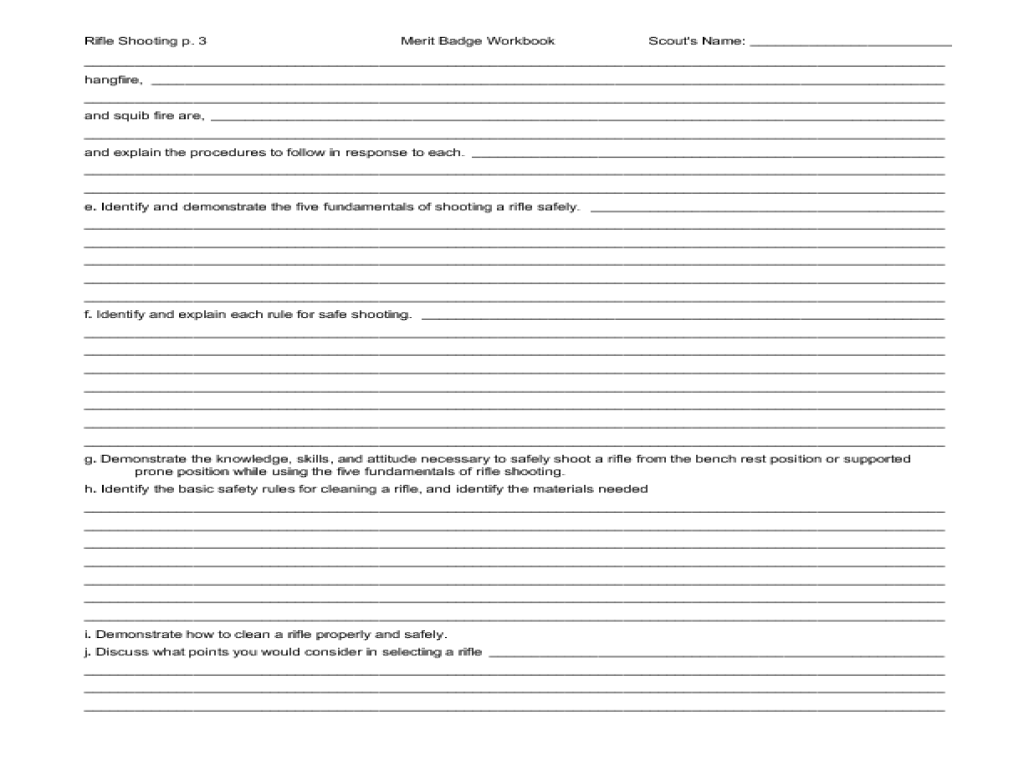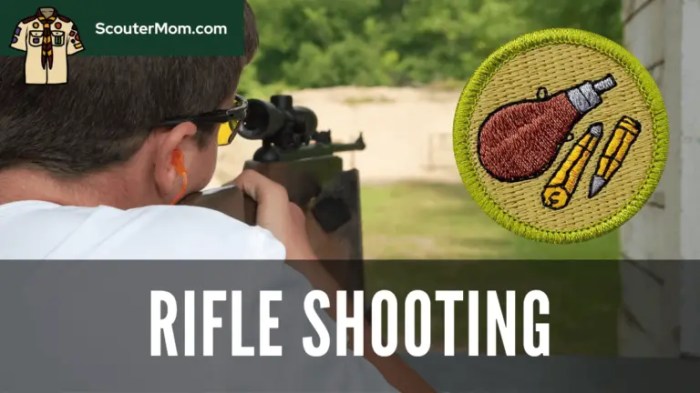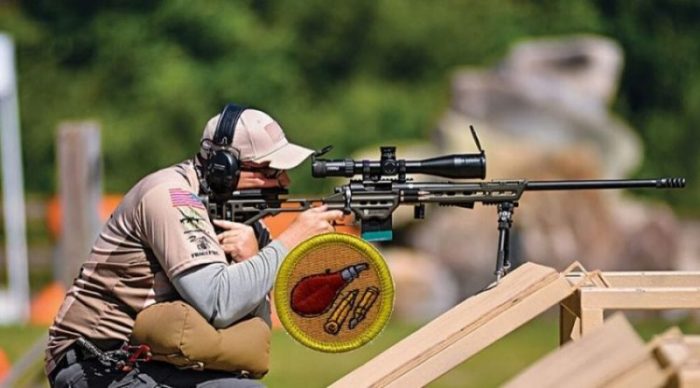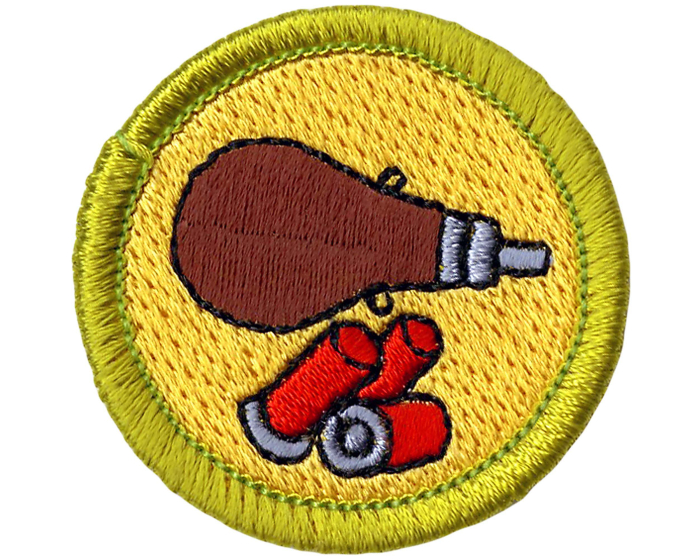The Rifle Shooting Merit Badge Worksheet is an indispensable resource for aspiring marksmen, providing a comprehensive overview of the fundamentals and advanced techniques of rifle shooting. This meticulously crafted guide delves into the intricacies of safety, marksmanship skills, rifle maintenance, and competition etiquette, empowering readers with the knowledge and skills necessary to excel in this demanding discipline.
From the proper handling and aiming of a rifle to the principles of trigger control and follow-through, this worksheet lays a solid foundation for developing sound shooting techniques. It emphasizes the paramount importance of safety, outlining the essential rules and regulations that must be strictly adhered to when handling firearms.
Rifle Shooting Merit Badge Overview

The Rifle Shooting merit badge is a program designed to introduce Scouts to the fundamentals of safe and responsible rifle shooting. It emphasizes the importance of firearm safety, proper shooting techniques, and ethical hunting practices.
To earn the merit badge, Scouts must complete a series of requirements that demonstrate their understanding of rifle shooting safety, marksmanship, and hunting ethics. These requirements include:
- Demonstrating safe firearm handling and shooting techniques.
- Qualifying as a marksman with a rifle.
- Understanding the principles of hunting ethics and wildlife management.
- Participating in a hunting or shooting event.
Importance of Safety in Rifle Shooting, Rifle shooting merit badge worksheet
Safety is paramount in rifle shooting. The merit badge program places a strong emphasis on teaching Scouts the importance of following all safety rules and procedures. These rules include:
- Always keep the firearm pointed in a safe direction.
- Never point the firearm at anything you do not intend to shoot.
- Be aware of your surroundings and identify potential hazards.
- Handle firearms only when you are authorized to do so.
- Store firearms unloaded and in a secure location.
By following these safety rules, Scouts can help prevent accidents and ensure that rifle shooting is a safe and enjoyable activity.
Basic Rifle Shooting Techniques
Mastering the fundamentals of rifle shooting is crucial for developing proficiency and ensuring safety on the range. This involves understanding proper handling techniques, shooting positions, trigger control, and follow-through.
Rifle Handling and Aiming
To ensure accuracy and stability, hold the rifle firmly with both hands. The non-dominant hand should support the fore-end, while the dominant hand grips the pistol grip. The rifle should rest comfortably on your shoulder, with the buttstock pressed against your cheekbone.
Align the sights with the target, ensuring that the front sight is level with the rear sight and the target.
Shooting Positions
Different shooting positions offer varying degrees of stability and comfort. The most common positions are:
- Standing:Provides the least stability but allows for quick target acquisition.
- Kneeling:Offers more stability than standing, reducing recoil and improving accuracy.
- Prone:The most stable position, providing maximum accuracy and recoil control.
Trigger Control and Follow-Through
Trigger control is crucial for precision shooting. Apply gentle, steady pressure to the trigger until it breaks. Avoid jerking or pulling the trigger, as this can disrupt the aim. Follow-through involves maintaining the rifle’s position after firing to ensure the bullet follows the intended trajectory.
Marksmanship Skills
Marksmanship is the ability to shoot accurately and consistently. It is a skill that takes practice and dedication to develop. Target practice and marksmanship drills are essential for improving your accuracy and consistency.
When shooting, it is important to adjust for wind and distance. Wind can cause your bullet to drift off course, so it is important to know the wind speed and direction before you shoot. Distance also affects the trajectory of your bullet, so you need to adjust your aim accordingly.
Tips for Improving Accuracy and Consistency
Here are some tips for improving your accuracy and consistency when shooting:
- Use a good quality rifle and ammunition.
- Practice regularly.
- Learn how to hold your rifle properly.
- Focus on your target.
- Follow through with your shot.
li>Control your breathing.
Rifle Safety and Maintenance

Firearm safety is paramount, ensuring responsible handling and preventing accidents. Understanding proper storage and maintenance techniques is crucial for the longevity of the rifle and the safety of those around it. Additionally, firearm owners have legal responsibilities to ensure their weapons are used safely and responsibly.
Safety Rules
- Treat every firearm as if it is loaded.
- Never point a firearm at anything you do not intend to shoot.
- Keep your finger off the trigger until you are ready to fire.
- Be aware of your surroundings and what is beyond your target.
- Only use ammunition that is specifically designed for your firearm.
- Never shoot under the influence of alcohol or drugs.
- Store firearms unloaded and in a secure location.
Storage and Maintenance
Proper storage and maintenance of a rifle ensure its longevity and safe operation. Rifles should be stored in a dry, secure location, unloaded, and with a trigger lock engaged. Regular cleaning and inspection are essential to prevent malfunctions and ensure the rifle is in good working order.
This includes cleaning the bore, lubricating moving parts, and checking for any signs of damage or wear.
Legal Responsibilities
Firearm owners have legal responsibilities to ensure their weapons are used safely and responsibly. These responsibilities vary depending on jurisdiction, but generally include:
- Storing firearms securely to prevent unauthorized access.
- Using firearms only for lawful purposes.
- Reporting lost or stolen firearms to the authorities.
- Complying with all applicable firearm laws and regulations.
Range Etiquette and Marksmanship Competition

Understanding range etiquette and participating in marksmanship competitions are integral aspects of rifle shooting. This section will provide an overview of range rules, the types of competitions, and tips for improving performance.
Range Etiquette
- Always follow the range rules and commands.
- Maintain a safe distance from other shooters and the firing line.
- Handle firearms responsibly and only when authorized.
- Be aware of your surroundings and never point a firearm at anything you do not intend to shoot.
- Wear appropriate safety gear, including earplugs and eye protection.
- Respect the range and its equipment.
Marksmanship Competitions
Marksmanship competitions provide opportunities to test skills and engage in friendly rivalry. There are various types of competitions, including:
- Bullseye shooting:Accuracy-based competition where shooters aim at a target with concentric circles.
- Silhouette shooting:Shooters engage metal silhouettes of animals at varying distances.
- Practical shooting:Involves shooting at multiple targets in a timed and dynamic course.
Tips for Improving Performance
To enhance performance in competitions, consider the following tips:
- Practice regularly.
- Develop a consistent shooting technique.
- Understand the fundamentals of marksmanship.
- Seek feedback from experienced shooters.
- Visualize success.
- Manage stress and maintain focus.
Advanced Rifle Shooting Techniques

Advanced rifle shooting techniques enhance marksmanship capabilities by incorporating specialized equipment and diverse shooting positions.Optics, such as scopes and red dot sights, magnify targets and provide precise aiming points, enabling shooters to engage distant targets with accuracy. Shooting from different positions, including prone, kneeling, and standing, adapts to various terrain and tactical scenarios, ensuring stability and control.
Long-Range Shooting
Long-range shooting requires precise compensation for bullet drop, the downward trajectory of projectiles due to gravity. Factors like bullet velocity, wind speed, and target distance influence bullet drop. Understanding these factors and adjusting aim accordingly is crucial for successful long-range marksmanship.
Developing Advanced Marksmanship Skills
Developing advanced marksmanship skills involves continuous practice, refinement of technique, and mastery of breathing control, trigger control, and follow-through. Regular target practice at varying distances and positions fosters consistency and accuracy. Analyzing shot placement and identifying areas for improvement helps refine technique.
Questions Often Asked: Rifle Shooting Merit Badge Worksheet
What are the key safety rules for rifle shooting?
Always keep the rifle pointed in a safe direction, treat every firearm as if it is loaded, and never point a firearm at anything you do not intend to shoot.
How do I properly hold and aim a rifle?
Hold the rifle firmly with both hands, with the stock against your shoulder and the buttstock in the palm of your hand. Align the sights with the target and focus on the front sight.
What are the different shooting positions?
The most common shooting positions are standing, kneeling, sitting, and prone. Each position offers advantages and disadvantages, depending on the shooting environment and target distance.
How do I adjust for wind and distance when shooting?
Wind can significantly affect bullet trajectory, so it is important to estimate the wind speed and direction and make appropriate adjustments to your aim. Similarly, distance also affects bullet drop, so you may need to adjust your elevation to compensate.